A new life for the US's abandoned railway stations
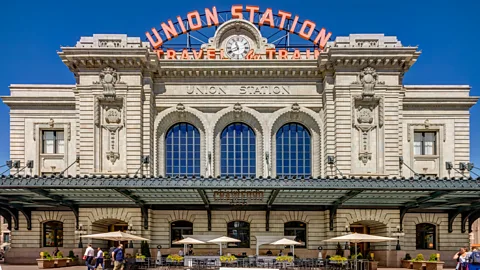 The Crawford
The CrawfordTrain stations were once the centrepieces of many US cities. After decades of neglect, many places are now reviving them in new, creative ways.
The trains don't stop at Union Pacific Depot anymore. So a hotel, the Asher Adams, was built within the former train station in Salt Lake City, Utah, and opened in October 2024. Refreshed with white and gilt detailing and long wooden benches interspersed with plush seats, the resulting space pulls a bit of a mind trick: are you lingering in a lobby or waiting for a train to arrive?
The Asher Adams is just one of a spate of recently restored train stations across the US that are being reclaimed as hotels, restaurants, museums and more.
From the late 1800s through the 1920s, many of the US's railway barons built grand train stations. These palaces not only testify to the "golden age of American railroading", but serve as a reminder of how the rapid growth of rail travel following the US Civil War helped settle the US West and transform the once-largely rural nation to a coast-to-coast collection of cities. As automobiles and, later, planes became more fashionable than trains, many of these railways consolidated or stopped running, leaving these once-bustling centrepieces of urban life empty.
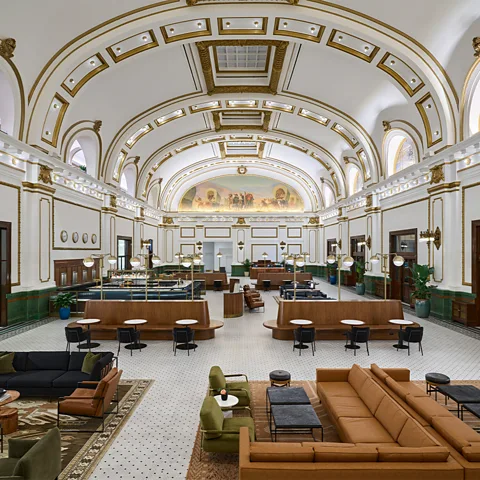 C&RC
C&RCSome stations burned down. Others were demolished. But over the past decade, cities have been finding creative ways to breathe new life into the historic structures, helping them regain their cultural cachet while offering travellers an intriguing glimpse into the past.
In the case of Asher Adams, tearing down the Union Pacific Depot wasn't an option. "The public had an emotional connection to it," recalled Emir Tursic, a partner with HKS Architects, which led the restoration. "It's part of our cultural heritage."
It's also one of the oldest buildings in Salt Lake City, he noted. Originally built between 1908 and 1909 as a bustling hub to merge multiple railway lines connecting the American North-west and South-west, the brick-and-sandstone structure hadn't been used for as a railway stop for decades. Instead, part of the structure had been converted into office space ahead of the 2002 Winter Olympics in Salt Lake City; another wing became a nightclub. "The rest was abandoned, especially during the pandemic."
What made this structure worth preserving? Aside from its emotional pull and landmarked status, Tursic says its sweeping Second Empire architecture, stained-glass windows, terrazzo floors and two large murals on either side of the hall (including Driving the Golden Spike, depicting the completion of the Transcontinental railroad in 1869).
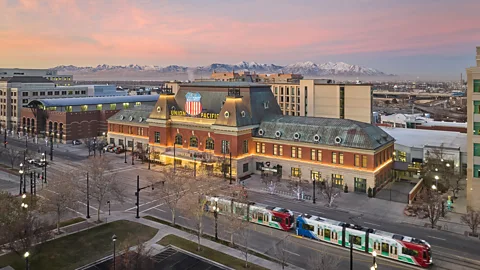 C&RC
C&RC"The craftsmanship simply doesn't exist anymore," Tursic said. "It has a significant value that would be impossible to replace."
Tursic also believes these revived spaces offer travellers a unique connection to local culture and history. The Asher Adams, for instance, is named after John Asher and John Adams, two cartographers who first mapped railroad routes throughout the West, and as media in Salt Lake have reported, "almost everything in [it is] a nod to Utah and railroad history".
"Today's travellers have more intellectual curiosity," Tursic explained. While a railway station-turned-hotel may not retain its original function, "both are related to travel, and this gives us a chance to restore the original character and spirit of the structure. It tells a story in itself: you can sit in the Great Hall and it takes you back." Not surprisingly, many visitors immediately take out their phones and start taking photos and videos. "That's what people are looking for: memorable experiences that are really hard to replicate."
A second reason for the reuse boom: location, location, location.
"A lot of towns and cities were built up around their train stations," said Glenn NP Nowak, associate professor of architecture at UNLV School of Architecture in Las Vegas, Nevada. As result, many of the structures are located in highly desirable areas. These stations were designed as a "gateway" to then-burgeoning locales, where travellers would disembark and get their first impressions of the city. As a result, many boast generously arched entryways or tall columns that strategically frame what are now historic downtowns or other attractions.
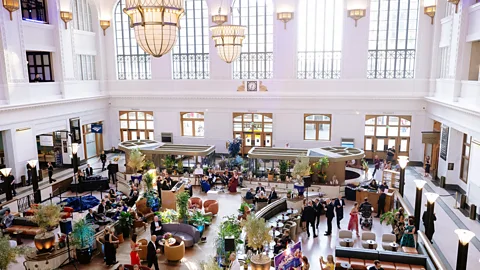 The Crawford
The Crawford"You had a sense of arrival," said Diana Melichar, president of Melichar Architects in Lake Forest, Illinois, and who has renovated several train stations in smaller communities. "They were the gateways to these 19th- and 20th-Century cities that were growing. Trains were the mode of transportation [and the message was], this is the grand entry to the town."
Perhaps the most expansive example is the recent transformation of Denver's Union Station into a massive hall encompassing a hotel (The Crawford), restaurants and retail spaces. While trains still whisk passengers from the airport to the hotel and the seasonal Winter Park Express train brings travellers and Denverites up to ski country, Union Station is no longer the robust train hub it was in its heyday.
It is, however, an awe-inspiring space. In addition to its enormous scale, it abounds with restored historic details – antique mirrors; subway tiles; the original ticketing office which has been transformed into a bar; and an old barber shop-turned local ice cream purveyor. Built in 1881 in the wake of the Colorado Gold Rush, the structure was remodelled twice; first by urban preservationist Dana Crawford who spearheaded a $38m revitalisation in 2014, followed by another elegant $11m makeover that was unveiled in July 2024.
"[Crawford] had a vision to restore Union Station back to its glory days, when there were 80 trains passing through," recalled Ed Blair, area general manager of Sage Hospitality Group, parent company to both the hotel and Union Station. Revived as "Denver's living room", the renovation has helped lure tourists and locals back to the city's centre.
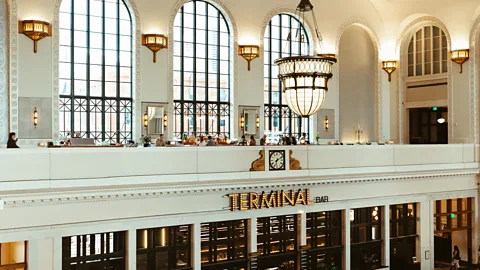 Mad Merry Photo
Mad Merry PhotoToday, it's a light-filled, multi-storey space, drawing creatives tapping on laptops and sipping locally roasted coffee from Pigtrain. Perhaps the best perch is after dark, from the Cooper Lounge on the second-storey mezzanine, where visitors have a birds-eye view of the 1900s domed-glass chandeliers and Manhattans arrive on shiny silver trays.
A third reason cited for the boom: sustainability. Most train stations were built for the long haul (pun intended), and to withstand the wear and tear of a steady flow of passengers.
More like this:
• The Swiss hotel cut off from the world for 12 hours a day
• Europe's stunning high-tech luxury train
• A new night train connecting some of Europe's great cities
"Economically and environmentally, it makes a lot of sense to preserve what you have, instead of tearing something down and building up something new," Melichar says. "If they have good bones, these buildings built of stone or brick will last another century."
Of course, not all train stations are palatial. For example, the former Westfield train station in Westfield, New Jersey, about 22 miles west of New York City, is a modestly sized stone-brick building built in 1892 that sits alongside an active commuter rail. Most recently used as office space, it had fallen into disrepair. After a 2.5-year renovation – which included removing dead birds from the roof – it re-opened in October 2024 as the Mexican restaurant Maize Cocina & Cocktails.
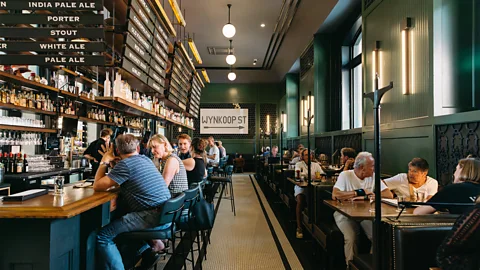 Mad Merry Photo
Mad Merry Photo"We could have gotten a vanilla box, or a turn-key restaurant," says Jesa Henneberry, partner and executive chef. "But we didn't want to tear down history. We wanted to breathe new life into it. I feel good we did that here."
Nods to the building's roots are sprinkled throughout the restaurant: wooden banquettes are styled like train station-style benches and cushions made from blue-and-white striped fabric evoke vintage train conductor hats. What was once the luggage room has been transformed into the kitchen and the former waiting room is now part of the bar, where visitors queue for margaritas, not train tickets.
Best of all, visitors can explore most of these new incarnations for free – or at least for the small price of a drink or museum ticket, as with the case of Cincinnati's Union Terminal, a dazzling Art Deco landmark now home to the Cincinnati History Museum and the Museum of Natural History & Science.
But most importantly, developing these historic spaces is about looking at current-day needs, and overlaying that with what the building has to offer, the pros say. A train station waiting room can be adapted into a unique cultural space – but only if you have an available train station to adapt.
"We like to say that you can't build history," said Blair.
--
If you liked this story, sign up for The Essential List newsletter – a handpicked selection of features, videos and can't-miss news, delivered to your inbox twice a week.
